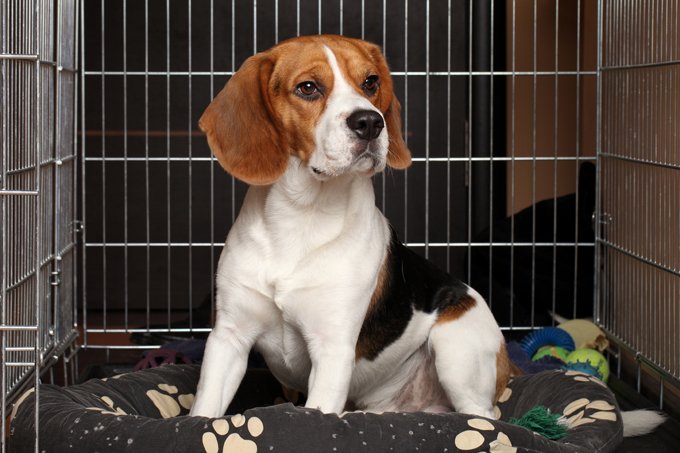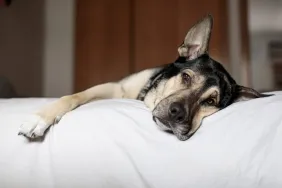Most dogs like a little alone time now and then. However, some dogs are extremely people-oriented and will act out when they are left alone. This is called separation anxiety.
Dogs with this affliction will show it within 20-45 minutes after you leave.
Typical behaviors are:
- Digging, gnawing, and scratching at doors and windows inside, and gates and fences outside. This is an attempt to break out of confinement and reconnect with their owners.
- Barking, whining and howling to try to get you to come back.
- Going potty in the house (even housetrained dogs) as a result of anguish.
Why do dogs develop separation anxiety?
We don’t fully understand why some dogs develop separation anxiety and others don’t. However, the destruction and house soiling that often marks separation anxiety are not your dog’s efforts to chastise or seek revenge with you for going away. Actually, these behaviors are the signs of a panic response.
Separation anxiety can occur:
- When you are leaving your dog alone for the first time.
- Following a long period, such as a long holiday weekend or vacation, when you have spent constant time with your dog.
- After a distressing event (from the dog’s viewpoint), such as time spent in a shelter or a first-time kennel stay.
- After altering the family’s routine or structure (a son or daughter leaving the home, a new job that keeps you away longer, a move to a new home, or introducing a new pet or person into the home).
How do I know if my dog has it?
Because there are many causes for the behaviors connected to separation anxiety, it’s important to properly identify the reason for the behavior before deciding on the right treatment.
If most, or all, of the statements that follow are true about your dog, it may be a separation anxiety problem:
- The behavior happens only or mostly when he is alone.
- He follows you around the house when you are home.
- He is overenthusiastic and frenetic when he greets you upon returning.
- The behavior happens regardless of how long he is left alone.
- He becomes excited, saddened, or anxious when you are getting ready to leave.
- He doesn’t like to spend time outside alone.
What should I do if my dog has separation anxiety?
For a slight separation anxiety issue, the following methods may be helpful by themselves. For more severe problems, these methods should be used along with the desensitization process explained in the next section.
- When you come home or leave your dog, keep it simple. For example, when you return from work, pay no attention to your dog for a short time, preferably until he sits or calms down a bit. Then you can pet and acknowledge him. It’s hard, especially when they are so happy, but it is an important step!
- Leaving a piece of clothing, such as a t-shirt you’ve just worn, can have a calming effect on your dog, because it has your scent.
- Create a “safety cue”–an action or word that you use every time you leave that tells your dog you’ll be back. Dogs learn to associate definite cues with the knowledge that you will come back. For example, when you go out to pick up the paper, your dog knows you come right back and doesn’t become worried. Therefore, it’s good to connect a safety cue with your short excursions.
Safety cue examples are turning on a radio or a television when you leave. Another is giving your dog a particular toy (one that doesn’t have dangerous fillings and can’t be torn into pieces) only when you go out. Use your safety cue while you train your dog. Never use your safety cue when you will be out longer than he’s prepared for; if you do, the safety cue will be useless.
If your dog’s separation anxiety behaviors include destructive chewing, a good safety cue would be a hard rubber toy like those that can be filled with treats or Nylabone®-like products.
Desensitization methods for severe cases
The prime treatment for more severe issues of separation anxiety is a systematic process of helping your dog to remain calm when alone. During this process, you will slowly get your dog to change his behavior when you are getting ready to leave and when you are going out for short periods.
The steps are as follows:
- Start by going through your normal routine, such as putting on your jacket and getting your keys out, and then sit back down. Repeat this step until your dog shows no anguish or excitement in reaction to your routine.
- Next, go through your routine and go to the door and open it, then sit back down.
- Next, step outside the door, but don’t close it, then return.
- Finally, step outside, close the door, and then come right back in. Slowly get your dog comfortable with being alone with the door closed between you for a couple of seconds. Progress gradually from step to step, and repeat each step until your dog shows zero signs of anguish.
You may have to repeat each step many times depending on the severity of the anxiety. If during any of these steps your dog shows anxiety behavior, you’ve moved too fast. Return to the preceding step in the process and practice until the dog shows no distress then move to the next step.
Once your dog is accepting of your being outside with the door closed for a few seconds, you can start with short time absences. Begin by giving your dog a verbal cue (for example, “Stay, I’ll return”), leaving, and then coming back within a minute. When you enter, keep it low-key. Ignore your dog for a while, and then greet him quietly and evenly.
If he shows no signs of anguish, repeat the exercise. If he appears uneasy, wait until he calms down to repeat the process. Gradually add to the amount of time you are away.
You should work on this step often being away less than ten minutes. If your dog remains calm and receptive, you can leave many times during a single session. Be sure to scatter your training throughout the day.
Once you have worked up to 30 to 90 minutes absences, your dog should be able to handle longer times without having to repeat the process each time you leave. The toughest part is when you begin, yet the task becomes easier as you move through the steps. Be sure to go slowly at first. The time it will take to get your dog used to being alone will depend on how severe the anxiety is.
Sit-stay and down-stay commands
A helpful command to train your anxious dog is “sit” or “down” combined with “stay.” The concept is to move out of your dog’s eyesight as he remains in this position. He will learn that it is okay to stay while you are gone and that you will return. To do this, start by giving the command and rewarding him with a treat and lots of “good boys.” Then, move a few steps away, come back, and reward him.
Progressively move farther away until you are out of his eyesight. As he improves, you can do this while you perform your normal routine. For example, if you’re reading the paper with your dog close by you may get up to answer phone or get a snack. When you get up to leave, give the sit or down command along with the stay command.
When you return, give him a reward with lots of praise. Never scold your dog during any training. He is trying to learn so he can please you!
Short-term solutions
All of the processes and treatments we have described can be long-term commitments. With separation anxiety, immediate help may be needed for your dog to protect him and your property from the damage he could cause under stress. These ideas may help you and your dog to deal with the anxiety in the interim:
- Discuss with your veterinarian if drug therapy would be good for your dog. A proper anti-anxiety prescription should reduce his anxiety while you’re gone without sedating him. These drugs are temporary solutions, not replacements for the behavior modification steps discussed earlier.
- Bring your dog to a daycare facility or hire a professional pet sitter to watch him during the day.
- Ask a friend, family member or neighbor to watch your dog while you are gone.
- If it’s allowed, bring your dog to work with you.
The “Don’ts” of separation anxiety treatment
- Never punish your dog. While separation anxiety can be frustrating (for both of you), punishment for destructive behavior quite simply does not work. In fact, punishing your dog after you return home may make the symptoms of separation anxiety worse.
- Don’t get another pet in hopes it will solve the problem. Separation anxiety is a result of being away from you, not simply being on his own.
- Don’t leave your dog in a crate for long periods of time. Confinement does not reduce anxiety and destructive behavior, such as fouling the crate, may still occur, but now he is stuck there, something most animals don’t like. This could lead to injuries if he then tries to escape from the crate.
- Don’t leave a radio or television on (unless your dog has been conditioned that this is a “safety cue,” as described above).
- Don’t rely on obedience training to fix the problem. Don’t take this the wrong way–obedience training is a very important part of raising a dog. It will not, however, fully solve a separation anxiety problem. Separation anxiety is not the effect of disobedience or lack of training; it’s a panic response.
Source: Adapted from the Humane Society of the United States









